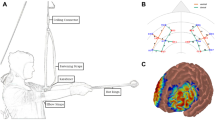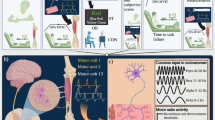Abstract
This study aimed to investigate the relationship between neural efficiency and the ability of an athlete to produce accurate efforts in different perceived intensity zones during a racing scenario. The α/β ratio was used to quantify the neural efficiency during cycling, as it traduced the degree of participants information processing activity with lower cortical activity possible. Twelve trained competitive male cyclists delimited their perceived intensity zones 2 to 6 on a scale to assess the rating of exercise intensity. Then, they performed a 30 min racing scenario during which they had to produce different perceived intensities. The ability of athletes to produce perceived effort with accuracy and their neural efficiency was quantified during the racing scenario. The increase in the neural efficiency with the increase in the effort intensity could partly explain the improvement in athletes’ ability to produce accurately perceived efforts from intensity zones 3 to 6. Moreover, the neural efficiency during the racing scenario was significantly correlated to the ability to produce perceived effort with accuracy at submaximal intensities.






Similar content being viewed by others
Data Availability
All data and material are available.
Abbreviations
- PO:
-
Power output
- IZ:
-
Intensity zones
- MC:
-
Motor cortex
- PFC:
-
Prefrontal cortex
- PC:
-
Parietal cortex
- RCP:
-
Respiratory compensation point
- RPE:
-
Rate of perceived exertion
- RSEI:
-
Rate of subjective exercise intensity
- HR:
-
Heart rate
- ES:
-
Effect size
- MAP:
-
Maximal aerobic power
- CAD:
-
Cadence
- POIZlow :
-
Mean relative PO at the lower limit of IZ (2 to 6)
- POIZmiddle :
-
Mean relative PO at the middle limit of IZ (2 to 6)
- POIZhigh :
-
Mean relative PO at the higher limit of IZ (2 to 6)
- POmean :
-
Mean PO during a racing scenario block
- PO%:
-
Difference between and POmean and POIZmiddle for each IZ
- FFT:
-
Fast Fourier transformed
- PSD:
-
Power spectral density
- TTE:
-
Time trial to exhaustion
References
Arnold, S., Cannas, M., & Caillard, B. (2018). Etude de la perception de l’intensité à travers l’expertise chez des cyclistes en condition de laboratoire. Master Degree, UPFR des Sports, Université de Franche Comté.
Baron, B., Grappe, F., & Groslambert, A. (2018). The global model of pacing process for long and ultra-long distance. Psychology, 09(14), 2837–2850. https://doi.org/10.4236/psych.2018.914163
Barwood, M. J., Corbett, J., Wagstaff, C. R. D., McVeigh, D., & Thelwell, R. C. (2015). Improvement of 10-km time-trial cycling with motivational self-talk compared with neutral self-talk. International Journal of Sports Physiology and Performance, 10(2), 166–171. https://doi.org/10.1123/ijspp.2014-0059
Barwood, M. J., Weston, N. J. V., Thelwell, R., & Page, J. (2009). A motivational music and video intervention improves high-intensity exercise performance. Journal of Sports Science & Medicine, 8, 435–442.
Borg, G. (1998). Borg’s perceived exertion and pain scales. Human Kinetics.
Bouillod, A., & Grappe, F. (2018). Physiological and biomechanical responses between seated and standing positions during distance-based uphill time trials in elite cyclists. Journal of Sports Sciences, 36(10), 1173–1178. https://doi.org/10.1080/02640414.2017.1363902
Callan, D. E., & Naito, E. (2014). Neural processes distinguishing elite from expert and novice athletes. Cognitive and Behavioral Neurology, 27(4), 183–188. https://doi.org/10.1097/WNN.0000000000000043
Chaumon, M., Bishop, D. V. M., & Busch, N. (2015). A practical guide to the selection of independent components of the electroencephalogram for artifact correction. Journal of Neuroscience Methods, 250, 47–63. https://doi.org/10.1016/j.jneumeth.2015.02.025
Cheron, G., Petit, G., Cheron, J., Leroy, A., Cebolla, A., Cevallos, C., et al. (2016). Brain oscillations in sport: Toward EEG biomarkers of performance. Frontiers in Psychology, 7, 246. https://doi.org/10.3389/fpsyg.2016.00246
Cohen, J. (1988). Set Correlation and Contingency Tables. Applied Psychological Measurement. https://doi.org/10.1177/014662168801200410
Comani, S., Di Fronso, S., Filho, E., Castronovo, A. M., Schmid, M., Bortoli, L., et al. (2014). Attentional focus and functional connectivity in cycling: An EEG case study. In L. M. Roa Romero (Ed.), XIII Mediterranean conference on medical and biological engineering and computing 2013 (Vol. 41, pp. 137–140). Springer. https://doi.org/10.1007/978-3-319-00846-2_34
Craig, A. (2003). Interoception: The sense of the physiological condition of the body. Current Opinion in Neurobiology, 13(4), 500–505. https://doi.org/10.1016/S0959-4388(03)00090-4
di Fronso, S., Tamburro, G., Robazza, C., Bortoli, L., Comani, S., & Bertollo, M. (2018). Focusing attention on muscle exertion increases EEG coherence in an endurance cycling task. Frontiers in Psychology, 9, 1249. https://doi.org/10.3389/fpsyg.2018.01249
Ekkekakis, P., Parfitt, G., & Petruzzello, S. J. (2011). The pleasure and displeasure people feel when they exercise at different intensities: Decennial update and progress towards a tripartite rationale for exercise intensity prescription. Sports Medicine, 41(8), 641–671. https://doi.org/10.2165/11590680-000000000-00000
Enders, H., Cortese, F., Maurer, C., Baltich, J., Protzner, A. B., & Nigg, B. M. (2016). Changes in cortical activity measured with EEG during a high-intensity cycling exercise. Journal of Neurophysiology, 115(1), 379–388. https://doi.org/10.1152/jn.00497.2015
Fontes, E. B., Bortolotti, H., Grandjean da Costa, K., Machado de Campos, B., Castanho, G. K., Hohl, R., et al. (2020). Modulation of cortical and subcortical brain areas at low and high exercise intensities. British Journal of Sports Medicine, 54(2), 110–115. https://doi.org/10.1136/bjsports-2018-100295
Fontes, E. B., Okano, A. H., De Guio, F., Schabort, E. J., Min, L. L., Basset, F. A., et al. (2015). Brain activity and perceived exertion during cycling exercise: An fMRI study. British Journal of Sports Medicine, 49(8), 556–560. https://doi.org/10.1136/bjsports-2012-091924
Grappe, F. (2005). Utilisation de la perception de l’effort comme outil d’estimation de l’intensité de l’exercice. In Sciences et Pratiques Du Sport. Cyclisme et Optimisation de la Performance (pp. 35–84). De Boeck.
Grappe, F. (2012). Puissance et performance en cyclisme. S’entraîner avec des capteurs de puissance. De Broeck.
Grappe, F. (2018). Utilisation de la perception de l’effort comme outil d’estimation de l’intensité de l’exercice. In Sciences et Pratiques Du Sport. Cyclisme et Optimisation de la Performance (pp. 41–90). De Boeck.
Groslambert, A., Baron, B., Ouvrard, T., Desmoulins, L., Lacroix, E., Gimenez, P., et al. (2020). Influencing factors of pacing variations and performance in a 44-kilometer mountain trail race. Advances in Physical Education, 10(02), 81–96. https://doi.org/10.4236/ape.2020.102008
Gutmann, B., Mierau, A., Hülsdünker, T., Hildebrand, C., Przyklenk, A., Hollmann, W., & Strüder, H. K. (2015). Effects of physical exercise on individual resting state EEG alpha peak frequency. Neural Plasticity, 2015, 1–6. https://doi.org/10.1155/2015/717312
Haase, L., Stewart, J. L., Youssef, B., May, A. C., Isakovic, S., Simmons, A. N., et al. (2016a). When the brain does not adequately feel the body: Links between low resilience and interoception. Biological Psychology, 113, 37–45. https://doi.org/10.1016/j.biopsycho.2015.11.004
Haase, L., Thom, N. J., Shukla, A., Davenport, P. W., Simmons, A. N., Stanley, E. A., et al. (2016b). Mindfulness-based training attenuates insula response to an aversive interoceptive challenge. Social Cognitive and Affective Neuroscience, 11(1), 182–190. https://doi.org/10.1093/scan/nsu042
Haier, R. J., Siegel, B. V., Nuechterlein, K. H., Hazlett, E., Wu, J. C., Paek, J., et al. (1988). Cortical glucose metabolic rate correlates of abstract reasoning and attention studied with positron emission tomography. Intelligence, 12(2), 199–217. https://doi.org/10.1016/0160-2896(88)90016-5
Hansen, E. A., Andersen, J. L., Nielsen, J. S., & Sjogaard, G. (2002). Muscle fibre type, efficiency, and mechanical optima affect freely chosen pedal rate during cycling. Acta Physiologica Scandinavica, 176(3), 185–194. https://doi.org/10.1046/j.1365-201X.2002.01032.x
Hilty, L. (2013). Cerebral processes mediating muscle fatigue in healthy humans. ETH Zurich.
Hüttermann, S., & Memmert, D. (2014). Does the inverted-U function disappear in expert athletes? An analysis of the attentional behavior under physical exercise of athletes and non-athletes. Physiology & Behavior, 131, 87–92. https://doi.org/10.1016/j.physbeh.2014.04.020
Kunzler, M. R., & Carpes, F. P. (2020). Intense cycling exercise improves acute cognitive responses. International Journal of Sports Medicine. https://doi.org/10.1055/a-1114-6170
Ludyga, S., Gronwald, T., & Hottenrott, K. (2015). Do male and female cyclists’ cortical activity differ before and during cycling exercise? Journal Sport and Exercise Psychology, 37(6), 617–625. https://doi.org/10.1123/jsep.2015-0078
Ludyga, S., Gronwald, T., & Hottenrott, K. (2016). The athlete’s brain: Cross-sectional evidence for neural efficiency during cycling exercise. Neural Plasticity, 2016, 4583674. https://doi.org/10.1155/2016/4583674
Ludyga, S., Hottenrott, K., & Gronwald, T. (2017). Four weeks of high cadence training alter brain cortical activity in cyclists. Journal of Sports Sciences, 35(14), 1377–1382. https://doi.org/10.1080/02640414.2016.1198045
Maceri, R. M., Cherup, N. P., & Hanson, N. J. (2019). EEG responses to incremental self-paced cycling exercise in young and middle aged adults. International Journal of Exercise Science, 12(3), 800–810.
Marcora, S. (2009). Perception of effort during exercise is independent of afferent feedback from skeletal muscles, heart, and lungs. Journal of Applied Physiology, 106(6), 2060–2062. https://doi.org/10.1152/japplphysiol.90378.2008
Neubauer, A. C., & Fink, A. (2009). Intelligence and neural efficiency: Measures of brain activation versus measures of functional connectivity in the brain. Intelligence, 37(2), 223–229. https://doi.org/10.1016/j.intell.2008.10.008
Olds, T. S., Norton, K. I., & Craig, N. P. (1993). Mathematical model of cycling performance. Journal of Applied Physiology, 75(2), 730–737. https://doi.org/10.1152/jappl.1993.75.2.730
Ouvrard, T., Groslambert, A., & Grappe, F. (2019). The influence of pleasure and attentional focus on performance and pacing strategies in elite individual time trials. International Journal of Sports Physiology and Performance, 14(4), 451–457. https://doi.org/10.1123/ijspp.2017-0773
Radel, R., Brisswalter, J., & Perrey, S. (2017). Saving mental effort to maintain physical effort: A shift of activity within the prefrontal cortex in anticipation of prolonged exercise. Cognitive, Affective, & Behavioral Neuroscience, 17(2), 305–314. https://doi.org/10.3758/s13415-016-0480-x
Robertson, C. V., & Marino, F. E. (2015). Prefrontal and motor cortex EEG responses and their relationship to ventilatory thresholds during exhaustive incremental exercise. European Journal of Applied Physiology, 115(9), 1939–1948. https://doi.org/10.1007/s00421-015-3177-x
Sharbrough, F., Chatrian, G. E., & Lesser, R. (1991). American electroencephalographic society guidelines for standard electrode position nomenclature. Journal of Clinical Neurophysiology, 8(2), 200–202. https://doi.org/10.1097/00004691-199104000-00007
Simmons, A. N., Fitzpatrick, S., Strigo, I. A., Potterat, E. G., Johnson, D. C., Matthews, S. C., et al. (2012). Altered insula activation in anticipation of changing emotional states: Neural mechanisms underlying cognitive flexibility in special operations forces personnel. Cognitive Neuroscience and Neuropsychology, 23(4), 234–239. https://doi.org/10.1097/WNR.0b013e3283503275
Gibson, S. C., & A., Lambert, E. V., Rauch, L. H. G., Tucker, R., Baden, D. A., Foster, C., & Noakes, T. D. (2006). The role of information processing between the brain and peripheral physiological systems in pacing and perception of effort. Sports Medicine, 36(8), 705–722. https://doi.org/10.2165/00007256-200636080-00006
Wagner, G., Herbsleb, M., de la Cruz, F., Schumann, A., Köhler, S., Puta, C., et al. (2017). Changes in fMRI activation in anterior hippocampus and motor cortex during memory retrieval after an intense exercise intervention. Biological Psychology, 124, 65–78. https://doi.org/10.1016/j.biopsycho.2017.01.003
Won, J., Alfini, A. J., Weiss, L. R., Michelson, C. S., Callow, D. D., Ranadive, S. M., et al. (2019). Semantic memory activation after acute exercise in healthy older adults. Journal of the International Neuropsychological Society, 25(6), 557–568. https://doi.org/10.1017/S1355617719000171
Zainuddin, N. F., Omar, A. H., Zulkapri, I., Jamaludin, M. N., & Miswan, M. S. (2017). Brainwave biomarkers of brain activity, physiology and biomechanics in cycling performance. Malaysian Journal of Fundamental and Applied Sciences, 13(4–2), 533–539. https://doi.org/10.11113/mjfas.v13n4-2.840
Funding
The authors didn’t receive any funding for this work.
Author information
Authors and Affiliations
Corresponding author
Ethics declarations
Conflict of interest:
Authors declare that they have no conflict of interests.
Ethical Approval
Each participant wrote informed consent, and the study was conducted following the ethical principles of the Declaration of Helsinki (1983) and approved by the regional ethics committee.
Additional information
Publisher's Note
Springer Nature remains neutral with regard to jurisdictional claims in published maps and institutional affiliations.
Supplementary Information
Below is the link to the electronic supplementary material.
Rights and permissions
About this article
Cite this article
Scholler, V., Groslambert, A., Grosprêtre, S. et al. Neural Efficiency and Ability to Produce Accurate Efforts in Different Perceived Intensity Zones. Appl Psychophysiol Biofeedback 46, 335–345 (2021). https://doi.org/10.1007/s10484-021-09517-z
Published:
Issue Date:
DOI: https://doi.org/10.1007/s10484-021-09517-z




